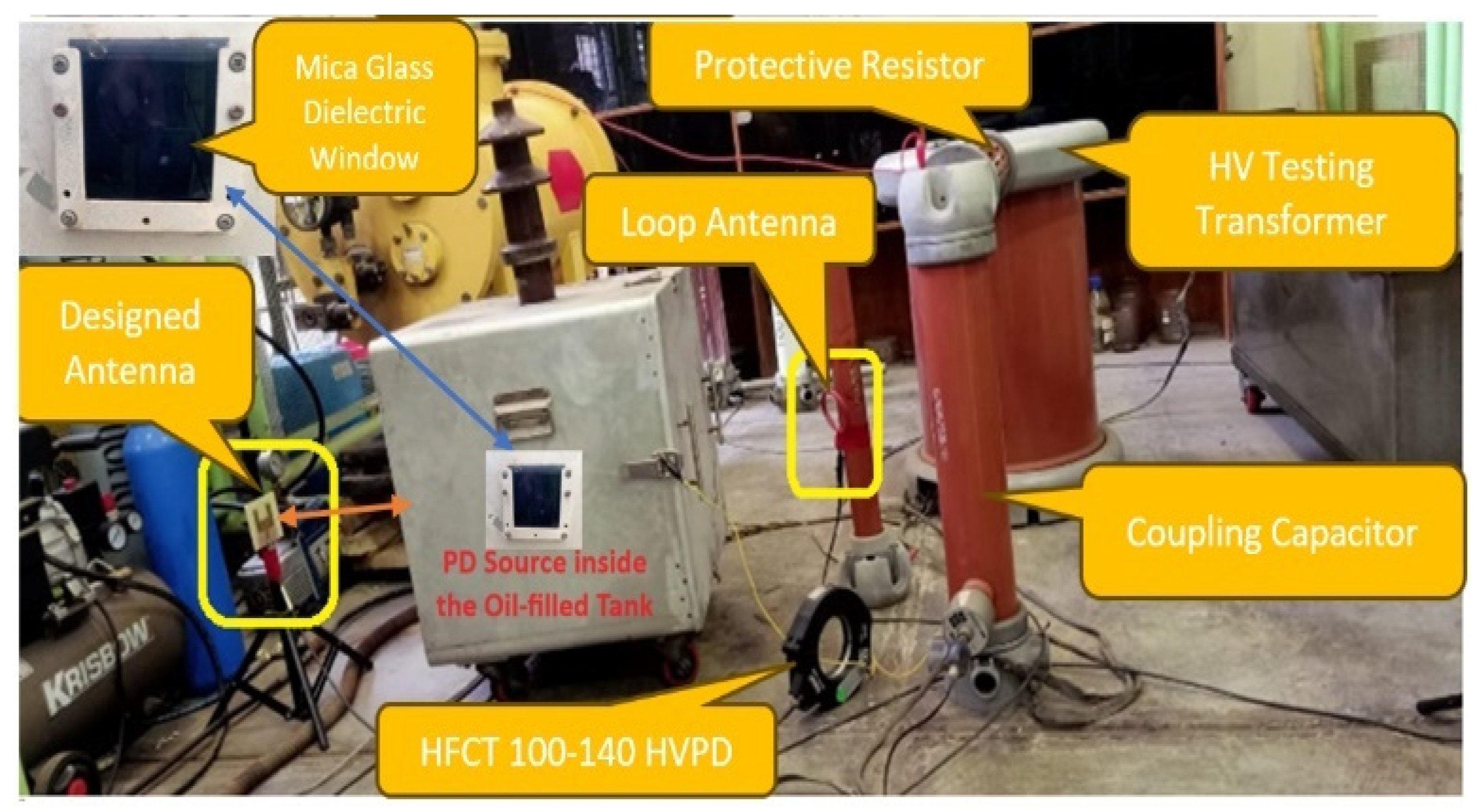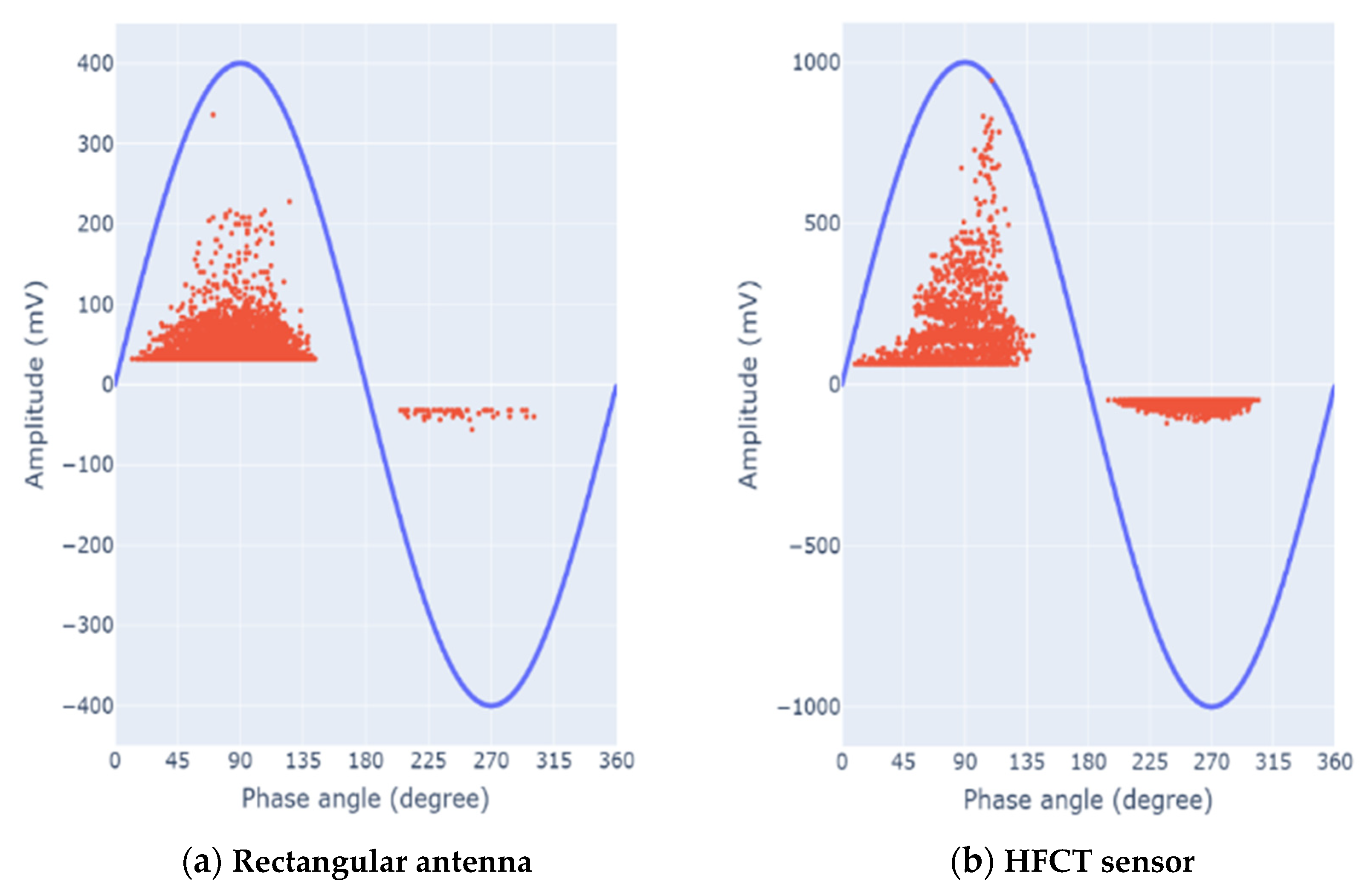Submitted:
25 June 2024
Posted:
26 June 2024
You are already at the latest version
Abstract
Keywords:
1. Introduction
2. Design and Fabrication of the Antenna
2.1. Design of Planar Rectangular Microstrip Antenna
2.2. Fabrication of Rectangular Microstrip Antenna
2.3. Simulation and Measurement Results
3. Experimental Validation
3.1. Artificial PD Defects
3.2. PD Measurement Set-Up
4. PD Measurement and Results Discussion
4.1. Breakdown Voltage Measurement
4.2. Ambient Noise Measurement
4.3. Surface and Corona Discharge Inception Voltage Measurements
4.4. PD Waveforms and Frequency Spectra
4.5. PRPS and PRPD Patterns for Corona Discharge in Oil Insulation
4. Conclusions
Author Contributions
Funding
Data Availability Statement
Acknowledgments
Conflicts of Interest
References
- Naderiallaf, H.; Seri, P.; Montanari, G.C. Designing a HVDC Insulation System to Endure Electrical and Thermal Stresses Under Operation. Part I: Partial Discharge Magnitude and Repetition Rate During Transients and in DC Steady State. IEEE Access 2021, 9, 35730–35739. [Google Scholar] [CrossRef]
- Dai, X.; Hao, J.; Montanari, G.C.; Jian, Z.; Liao, R.; Zheng, X. Influence of thermal ageing on high-field polarization characteristics and conductivity behavior of submarine polymeric cables insulation. High Voltage 2023, 8, 138–148. [Google Scholar] [CrossRef]
- Besharatifard, H.; Hasanzadeh, S.; HeydarianForushani, E.; Alhelou, H.H.; Siano, P. Detection and Analysis of Partial Discharges in Oil-Immersed Power Transformers Using Low-Cost Acoustic Sensors. Appl. Sci. 2022, 12, 3010. [Google Scholar] [CrossRef]
- Santosh Kumar, A.; Gupta, R.P.; Udayakumar, K.; Venkatasam, A. Online Partial Discharge Detection and Location Techniques for Condition Monitoring of Power Transformers: A Review. In Proceedings of the 2008 International Conference on Condition Monitoring and Diagnosis, Beijing, China, 21–24 April 2008. [Google Scholar]
- Sikorski, W.; Walczak, K.; Gil, W.; Szymczak, C. On-Line Partial Discharge Monitoring System for Power Transformers Based on the Simultaneous Detection of High Frequency, Ultra-High Frequency, and Acoustic Emission Signals. Energies 2020, 13, 327. [Google Scholar] [CrossRef]
- Gulski, E.; Wojciech, K.; Ariaans, T.H.P.; Behrmann, G.; Jongen, R.; Garnacho, F.; Kornhuber, S.; Ohtsuka, S.; Petzold, F.; Sánchez-Urán, M.A.; Siodła, K.; Tenbohlen, S. Guidelines for partial discharge detection using conventional (IEC 60270) and unconventional methods (2016).
- Azam, S.M.K.; Othman, M.; Illias, H.A.; Abdul Latef, T.; Tariqul Islam, M.; Fadzil Ain, M. Ultra-high frequency printable antennas for partial discharge diagnostics in high voltage equipment. Alexandria Engineering Journal 2023, 64, 709–729. [Google Scholar] [CrossRef]
- Tenbohlen, S.; Beura, C.P.; Sikorski, W.; Albarracín Sánchez, R.; de Castro, B.A.; Beltle, M.; Fehlmann, P.; Judd, M.; Werner, F.; Siegel, M. Frequency Range of UHF PD Measurements in Power Transformers. Energies 2023, 16, 1395. [Google Scholar] [CrossRef]
- Xavier, G.V.R.; de Oliveira, A.C.; Silva, A.D.C.; Nobrega, L.A.M.M.; da Costa, E.G.; Serres, A.J.R. Application of Time Difference of Arrival Methods in the Localization of Partial Discharge Sources Detected Using Bio-Inspired UHF Sensors. IEEE Sensors Journal 2021, 21, 1947–1956. [Google Scholar] [CrossRef]
- Coenen, S.; Tenbohlen, S. Location of PD Sources in Power Transformers by UHF and Acoustic Measurements. IEEE Trans. Dielectr. Electr. Insul. 2012, 19, 1934–1940. [Google Scholar] [CrossRef]
- Zhang, S.; Zhang, G.; Lu, C.; Tian, H.; Liu, J.; Zhang, X. Flexible Planar Monopole Built-in GIS PD Sensor Based on Meandering Technology. Sensors 2022, 22, 4134. [Google Scholar] [CrossRef] [PubMed]
- Zhang, H.; Zhang, G.; Zhang, X.; Tian, H.; Lu, C.; Liu, J.; Zhang, Y. PD Flexible Built-In High-Sensitivity Elliptical Monopole Antenna Sensor. Sensors 2022, 22, 4982. [Google Scholar] [CrossRef]
- Judd, M.D.; Farish, O.; Pearson, J.S.; Hampton, B.F. Dielectric windows for UHF partial discharge detection. IEEE Trans. Dielectr. Electr. Insul. 2001, 8, 953–958. [Google Scholar] [CrossRef]
- Judd, M.D.; Yang, L.; Hunter, I.B.B. Partial discharge monitoring of power transformers using UHF sensors. Part I: sensors and signal interpretation. IEEE Electr Insul Magaz. 2005, 21, 5–14. [Google Scholar] [CrossRef]
- Zahed, A.A.; El-Hag, A.H.; Qaddoumi, N.; Hussein, R.; Shaban, K.B. Comparison of different fourth order Hilbert fractal antennas for partial discharge measurement. IEEE Trans. Dielectr. Electr. Insul. 2017, 24, 175–182. [Google Scholar] [CrossRef]
- Yadam, Y.R.; Sarathi, R.; Arunachalam, K. Planar Ultrawideband Circularly Polarized Cosine Slot Archimedean Spiral Antenna for Partial Discharge Detection. IEEE Access 2022, 10, 35701–35711. [Google Scholar] [CrossRef]
- Qi, Y.; Yang, F.; Gao, B.; Ran, J.; Wang, S.; Shen, W.; Ammad, J. Design of Ultra-Wide Band Metal-Mountable Antenna for UHF Partial Discharge Detection. IEEE Access 2019, 7, 60163–60170. [Google Scholar] [CrossRef]
- Uwiringiyimana, J.P.; Khayam, U.; Suwarno; Montanari, G.C. Comparative Analysis of Partial Discharge Detection Features Using a UHF Antenna and Conventional HFCT Sensor. IEEE Access 2022, 10, 107214–107226. [Google Scholar] [CrossRef]
- Azam, S.M.K.; Othman, M.; Hazlee, A.I.; Tarik, A.L.; Wan, N.L.M.; Daniar, F.; Hossain Zakir, A.K.M.; Mohd, F.A. Planar Sensor for Noise Cancellation During Partial Discharge Detection in Open Substation. IEEE Sensors Journal 2023, 23, 15552–15562. [Google Scholar] [CrossRef]
- Chai, H.; Phung, B.T.; Zhang, D. Development of UHF Sensors for Partial Discharge Detection in Power Transformer. In Proceedings of the 2018 International Conference on Condition Monitoring and Diagnosis, Perth, WA, Australia; 2018; pp. 1–5. [Google Scholar]
- Nobrega, L.A.M.M.; Xavier, G.V.R.; Aquino, M.V.D.; Serres, A.J.R.; Albuquerque, C.C.R.; Costa, E.G. Design and development of a bio-inspired UHF sensor for partial discharge detection in power transformers. Sensors 2019, 19, 653. [Google Scholar] [CrossRef]
- Xavier, G.V.R.; da Costa, E.G.; Serres, A.J.R.; Nobrega, L.A.M.M.; Oliveira, A.C.; Sousa, H.F.S. Design and application of a circular printed monopole antenna in partial discharge detection. IEEE Sensors Journal 2019, 19, 3718–3725. [Google Scholar] [CrossRef]
- Uwiringiyimana, J.P.; Khayam, U. Design and application of double layer bowtie antenna and single layer bowtie antenna as UHF sensors for partial discharge detection. IOP Conf. Ser.: Mater. Sci. Eng. 2020; 850, 012036. [Google Scholar] [CrossRef]
- Rozi, F.; Khayam, U. Development of Loop Antennas for Partial Discharge Detection. Int. Journ Electr. Eng.and Inform. 2015, 7, 29–41. [Google Scholar] [CrossRef]
- Yang, F.; Peng, C.; Yang, Q.; Luo, H.; Ullah, I.; Yang, Y. An UWB Printed Antenna for Partial Discharge UHF Detection in High Voltage Switchgears. Progress In Electromagnetics Research C 2016, 69, 105–114. [Google Scholar] [CrossRef]
- Uwiringiyimana, J.P.; Suwarno; Khayam, U. Design of a Rectangular Microstrip Patch Antenna as UHF Sensor for Partial Discharge Detection on Power Transformer. In Proceedings of the 2021 3rd International Conference on High Voltage Engineering and Power Systems (ICHVEPS), Bandung, Indonesia, Bandung, Indonesia, 5–6 October 2021; pp. 563–568.
- Zhang, H.; Blackburn, T.R.; Phung, B.T.; Sen, D. A novel wavelet transform technique for on-line partial discharge measurements. 2. On-site noise rejection application. IEEE Trans. Dielectr. Electr. Insul. 2007, 14, 15–22. [Google Scholar] [CrossRef]
- Suwarno, D. A Model and Computer Simulation of Partial Discharges in High Voltage Liquid Insulation. In Proceedings of the 2010 Fourth Asia International Conference on Mathematical/Analytical Modelling and Computer Simulation, Kota Kinabalu, Malaysia, 26–28 May 2010; pp. 444–449. [Google Scholar]
- Swati, K.; Yadav, K.S.; Sarathi, R.; Vinu, R.; Danikas, M.G. Understanding Corona discharge activity in titania nanoparticles dispersed in transformer oil under AC and DC voltages. IEEE Trans. Dielectr. Electr. Insul. 2017, 24, 2325–2336. [Google Scholar] [CrossRef]
- Sun, J.; Li, X.; Zhu, L.; Ji, S.; Cui, Y. Partial discharge of needle-plane defect in oil-paper insulation under AC and DC combined voltages: Developing processes and characteristics. Energies 2017, 10, 1759. [Google Scholar] [CrossRef]
- Rodrigo Mor, A.; Castro Heredia, L.; Harmsen, D.; Muñoz, F. A new design of a test platform for testing multiple partial discharge sources. Int. J. Electr. Power Energy Syst. 2018, 94, 374–384. [Google Scholar] [CrossRef]
- Zhang, C.; Dong, M.; Ren, M.; Huang, W.; Zhou, J.; Gao, X.; Albarracín, R. Partial discharge monitoring on metal-enclosed switchgear with distributed non-contact sensors. Sensors 2018, 18, 551. [Google Scholar] [CrossRef]
- Kang, A.; Tian, M.; Li, C.; Song, J.; Suraci, S.V.; Li, W.; Lin, L.; Lei, Z.; Fabiani, D. Development and pattern identification of end-winding discharge under effect of relative humidity and temperature for HV motors. High Voltage 2020, 5, 434–443. [Google Scholar] [CrossRef]















| Antenna characteristic parameters | Simulation results | Measurement results |
|---|---|---|
| Return loss, RL1 (dB) | -48 | -31.6 |
| Return Loss, RL2 (dB) | -37 | -26.8 |
| Fresonance 1 (GHz) | 1.55 | 1.63 |
| Fresonance2 (GHz) | 2.3 | 2.26 |
| Total Bandwidth | 1.37GHz-2.61GHz胡瑾(1.24GHz) | 1.44GHz-2.59GHz胡瑾(1.15GHz) |
| VSWR1 | 1.01 | 1.06 |
| VSWR2 | 1.03 | 1.09 |
| Antenna and HFCT Sensor Position | Applied Voltage | |||
| Voltage level | ||||
| 10kV | 12kV | 14kV | 16kV | |
| Surface PD signal amplitude (peak-to-peak voltage) detected by rectangular antenna placed at 50cm from the tank wall | 380mV | 404mV | 488mV | 560mV |
| Surface PD signal amplitude (peak-to-peak voltage) detected by loop antenna placed at 50cm from the tank wall | 90mV | 94mV | 116mV | 140mV |
| Surface PD signal amplitude (Peak-to-peak Voltage) detected by the commercial HFCT sensor clamped across ground wire | 336mV | 376mV | 484mV | 528mV |
Disclaimer/Publisher’s Note: The statements, opinions and data contained in all publications are solely those of the individual author(s) and contributor(s) and not of MDPI and/or the editor(s). MDPI and/or the editor(s) disclaim responsibility for any injury to people or property resulting from any ideas, methods, instructions or products referred to in the content. |
© 2024 by the authors. Licensee MDPI, Basel, Switzerland. This article is an open access article distributed under the terms and conditions of the Creative Commons Attribution (CC BY) license (http://creativecommons.org/licenses/by/4.0/).




